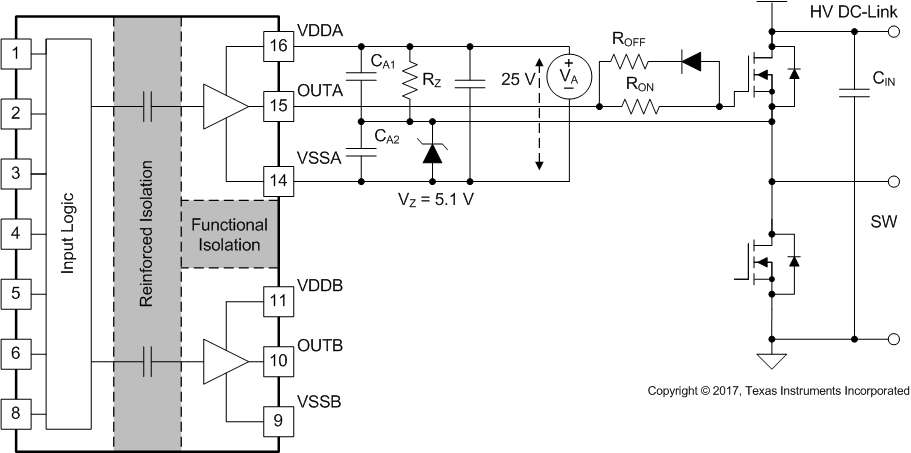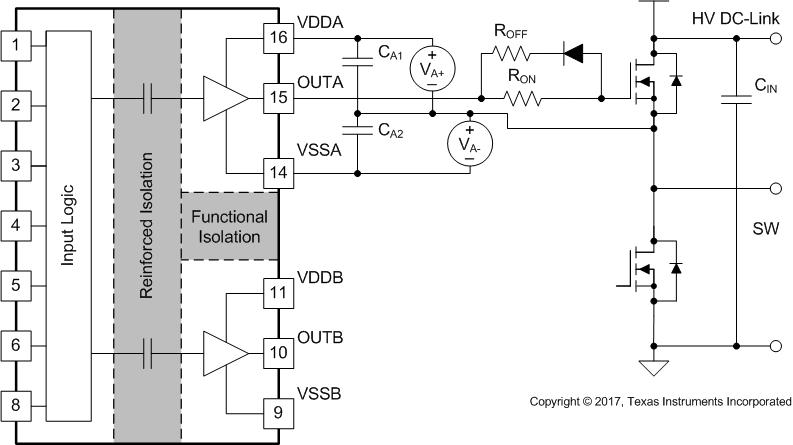ZHCSF55F June 2016 – November 2024 UCC21520
PRODUCTION DATA
- 1
- 1 特性
- 2 应用
- 3 说明
- 4 说明(续)
- 5 引脚配置和功能
- 6 规格
- 7 参数测量信息
- 8 详细说明
- 9 应用和实施
- 10电源相关建议
- 11布局
- 12器件和文档支持
- 13修订历史记录
- 14机械、封装和可订购信息
封装选项
请参考 PDF 数据表获取器件具体的封装图。
机械数据 (封装 | 引脚)
- DW|16
散热焊盘机械数据 (封装 | 引脚)
- DW|16
订购信息
9.2.2.9 具有输出级负偏置的应用电路
当非理想 PCB 布局和较长的封装引线(例如 TO-220 和 TO-247 型封装)引入寄生电感时,功率晶体管的栅极源驱动电压在高 di/dt 和 dv/dt 开关期间可能会出现振铃。如果振铃超过阈值电压,就有意外导通甚至发生击穿的风险。在栅极驱动上施加负偏置是一种可以将振玲保持在阈值以下的常用方法。下面是实现负栅极驱动偏置的几个例子。
图 9-2 展示了通过在隔离式电源输出级使用齐纳二极管来在通道 A 驱动器上生成负偏置关断的第一个例子。负偏置由齐纳二极管电压设置。如果隔离式电源 VA 等于 25 V,则关断电压为 –5.1V,导通电压为 25 V – 5.1V ≈ 20 V。通道 B 驱动器电路与通道 A 的相同,因此该配置需要两个用于半桥配置的电源,并且 RZ 上存在稳态功耗。
 图 9-2 利用 ISO 偏置电源输出上的齐纳二极管生成负偏置
图 9-2 利用 ISO 偏置电源输出上的齐纳二极管生成负偏置图 9-3 展示了采用两个电源(或单输入双输出电源)的另一个例子。电源 VA+ 决定正驱动输出电压,而 VA– 决定负关断电压。通道 B 的配置与通道 A 的相同。此解决方案所需的电源数量要比第一个例子中的多,不过它在设置正负电源轨电压时提供了更大的灵活性。
 图 9-3 利用两个 LSO 偏置电源生成负偏置
图 9-3 利用两个 LSO 偏置电源生成负偏置如图 9-4 所示,最后一个例子是单电源配置,并通过栅极驱动环路中的齐纳二极管来生成负偏置。此解决方案的优势是只使用一个电源,并且自举电源可用于高侧驱动。在这三种解决方案中,此设计的成本最低,所需设计工作量也最少。不过,此解决方案有以下局限性:
- 负栅极驱动偏置不仅由齐纳二极管决定,而且还由占空比决定,这意味着负偏置电压会随着占空比的变化而变化。因此,在此解决方案中,使用变频谐振转换器或相移转换器等具有固定占空比(约 50%)的转换比较有利。
- 高侧 VDDA-VSSA 必须维持足够的电压来保持在建议的电源电压范围内,这意味着低侧开关必须导通或在体(或反向并联)二极管上存在续流电流,以便在每个开关周期的特定时期内刷新自举电容器。因此,除非像其他两个示例电路那样,高侧也使用专用电源,否则高侧无法实现 100% 占空比。
 图 9-4 使用单电源和栅极驱动路径上的齐纳二极管产生负偏置
图 9-4 使用单电源和栅极驱动路径上的齐纳二极管产生负偏置